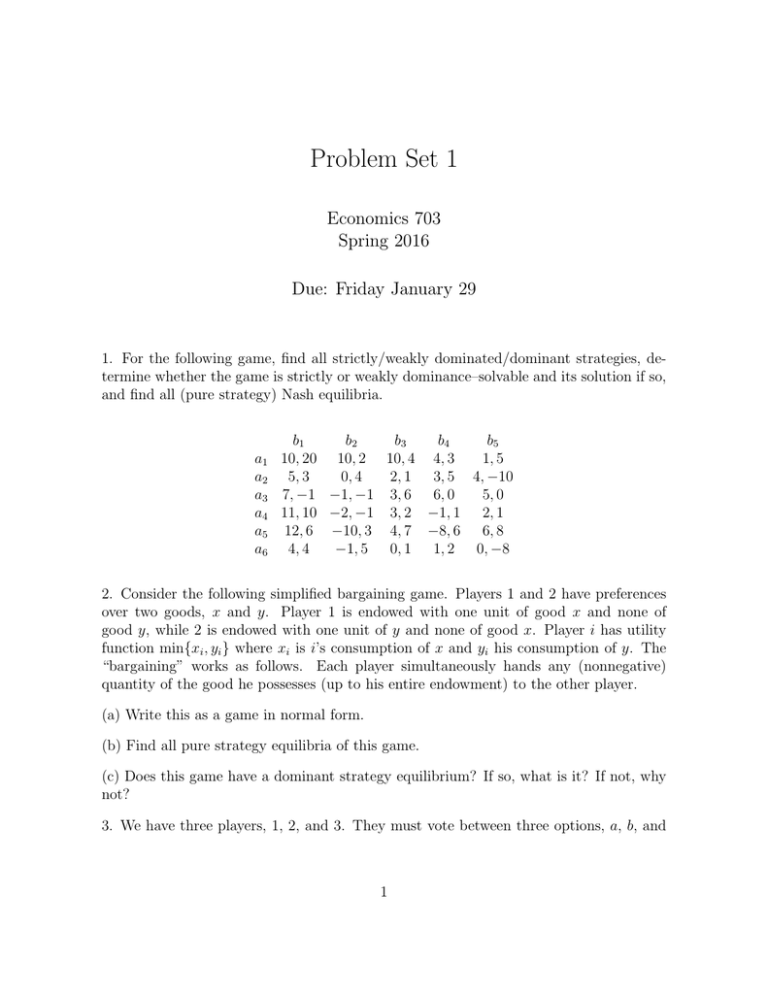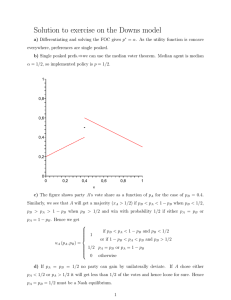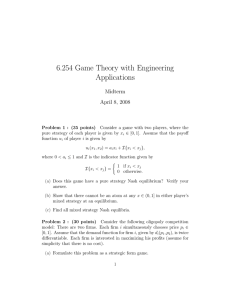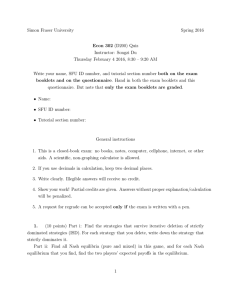Problem Set 1 Economics 703 Spring 2016 Due: Friday January 29
advertisement

Problem Set 1
Economics 703
Spring 2016
Due: Friday January 29
1. For the following game, find all strictly/weakly dominated/dominant strategies, determine whether the game is strictly or weakly dominance–solvable and its solution if so,
and find all (pure strategy) Nash equilibria.
a1
a2
a3
a4
a5
a6
b1
b2
b3
b4
b5
10, 20 10, 2 10, 4 4, 3
1, 5
5, 3
0, 4
2, 1 3, 5 4, −10
7, −1 −1, −1 3, 6 6, 0
5, 0
11, 10 −2, −1 3, 2 −1, 1 2, 1
12, 6 −10, 3 4, 7 −8, 6 6, 8
4, 4
−1, 5 0, 1 1, 2 0, −8
2. Consider the following simplified bargaining game. Players 1 and 2 have preferences
over two goods, x and y. Player 1 is endowed with one unit of good x and none of
good y, while 2 is endowed with one unit of y and none of good x. Player i has utility
function min{xi , yi } where xi is i’s consumption of x and yi his consumption of y. The
“bargaining” works as follows. Each player simultaneously hands any (nonnegative)
quantity of the good he possesses (up to his entire endowment) to the other player.
(a) Write this as a game in normal form.
(b) Find all pure strategy equilibria of this game.
(c) Does this game have a dominant strategy equilibrium? If so, what is it? If not, why
not?
3. We have three players, 1, 2, and 3. They must vote between three options, a, b, and
1
c. Their utilities for these three options are:
1
a 3
b 2
c 1
2
2
1
3
3
1
3
2
Note: This is not the normal form — it’s just a table for summarizing the utilities. Each
agent cares only about the outcome, not what he votes for. So, for example, if a wins,
regardless of how it wins, 1’s utility is 3, 2’s utility is 2, and 3’s utility is 1.
The voting is by secret ballot. Each player votes for one alternative. The outcome is
determined by majority rule whenever possible, so if any option gets two or more votes,
it wins. If there is a three–way tie, the winner is whatever outcome player 1 voted for.
Write this as a game in normal form. Find the pure strategy Nash equilibria. Is this
game dominance solvable? If so, what is the solution?
4. Fix a finite normal form game G. Show each of the following:
(a) A strict dominant strategy equilibrium is a Nash equilibrium. A dominant strategy
equilibrium is a Nash equilibrium.
(b) If a game has a unique rationalizable outcome, then this is the only Nash equilibrium
of the game.
(c) If a game is dominance solvable, the solution is a Nash equilibrium but need not be
the only Nash equilibrium of the game.
2











